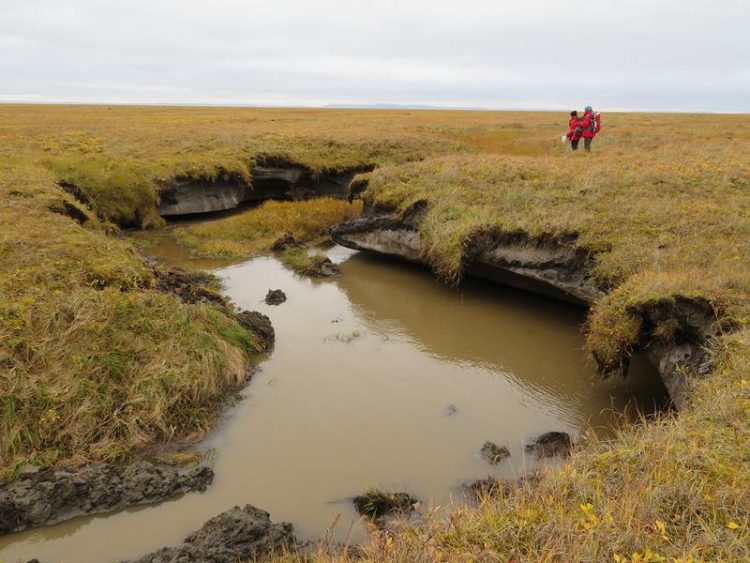Why permafrost might thaw sooner than expected

Thawing of ice-rich permafrost through Thermokarst processes on the island of Kurungnakh in the Lena Delta. Photo: Jan Nitzbon
Experts from the Alfred Wegener Institute, Helmholtz Centre for Polar and Marine Research (AWI), the Humboldt-Universität zu Berlin (HU) and the University of Oslo have determined that much of the permafrost that is currently still very cold might disappear by the end of the century.
What’s new about their simulations: the inclusion of thermokarst processes. The outcomes of the study have just been released in the journal Nature Communications.
Climate change is producing higher temperatures, and is especially causing the permafrost soils found in higher latitudes and mountainous regions to thaw. When this happens, large quantities of greenhouse gases can be released into the atmosphere, where they intensify global warming.
Another consequence: due to the melting ice, these soils lose their stability, resulting in the formation of small and large depressions as well as landslides. This change in the landscape is referred to as thermokarst.
Using new computer models, experts from the Alfred Wegener Institute, Helmholtz Centre for Polar and Marine Research, the Humboldt-Universität zu Berlin and the University of Oslo have taken a closer look at how thermokarst processes can affect the thawing of permafrost in northeast Siberia, a region that is home to extremely cold and therefore presumably stable permafrost, in a range of climate warming scenarios.
“What we’ve determined is that, if thermokarst processes are taken into account, a great deal of the permafrost that is currently still very cold, say, roughly minus ten degrees, could be gone by the end of this century. In contrast, if thermokarst is disregarded, the permafrost mostly remains stable in the models’ projections,” says geo-researcher Jan Nitzbon, who is currently pursuing his doctorate at the AWI and the Humboldt-Universität zu Berlin.
Thermokarst processes are widespread in the ice-rich permafrost of Siberia and Alaska, yet they have largely been ignored in efforts to model the development of permafrost in response to climate warming.
In recent years permafrost researchers have observed that, on a local scale, thermokarst processes can accelerate the thawing of permafrost. “Our findings largely confirm this. However, we also factored in stabilising processes that could slow the thawing. We were amazed to find that, in a moderate warming scenario, these braking processes could significantly limit the rapid thawing of permafrost,” Nitzbon explains.
Nevertheless, in a more intensive warming scenario, this factor was outweighed by positive feedback processes, which resulted in extensive permafrost thawing and dramatic landscape changes.
For their study, the researchers developed new methods that are intended to enhance Earth system models, since they can more realistically reflect permafrost thawing in a warming Arctic.
The team’s findings also indicate that limiting anthropogenic global warming could help to protect Arctic ecosystems from the massive changes accompanying the thawing of ice-rich permafrost.
Jan Nitzbon
Alfred Wegener Institute, Helmholtz Centre for Polar and Marine Research
Telegrafenberg A45
14473 Potsdam
jan.nitzbon@awi.de
Nature Communications. Jan Nitzbon, Sebastian Westermann, Moritz Langer, Léo C. P. Martin, Jens Strauss, Sebastian Laboor, Julia Boike: Fast response of cold ice-rich permafrost in northeast Siberia to a warming climate. Doi. 10.1038/s41467-020-15725-8.
Media Contact
More Information:
https://www.hu-berlin.deAll latest news from the category: Earth Sciences
Earth Sciences (also referred to as Geosciences), which deals with basic issues surrounding our planet, plays a vital role in the area of energy and raw materials supply.
Earth Sciences comprises subjects such as geology, geography, geological informatics, paleontology, mineralogy, petrography, crystallography, geophysics, geodesy, glaciology, cartography, photogrammetry, meteorology and seismology, early-warning systems, earthquake research and polar research.
Newest articles

How marine worms regenerate lost body parts
The return of cells to a stem cell-like state as the key to regeneration. Many living organisms are able to regenerate damaged or lost tissue, but why some are particularly…

Nano-scale molecular detective
New on-chip device uses exotic light rays in 2D material to detect molecules. Researchers have developed a highly sensitive detector for identifying molecules via their infrared vibrational “fingerprint”. Published in Nature…

Novel CAR T-cell therapy
… demonstrates efficacy and safety in preclinical models of HER2-positive solid tumors. The p95HER2 protein is found expressed in one third of HER2+ tumors, which represent 4% of all tumors….



